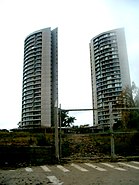Tequitinitlan
This article is incomplete because it is pending further input from participants, or it is a work-in-progress by one author. Please comment on this article's talk page to share your input, comments and questions. Note: To contribute to this article, you may need to seek help from the author(s) of this page. |
Tequitinitlan
𐐻𐐯𐐿𐐶𐐨𐐻𐐨𐑌𐐨𐐻𐑊𐐰𐑌 | |
|---|---|
|
Clockwise from top: Cityscape of the central wards, Green River Business Center, Coral Tower | |
| Country | Zacapican |
| Republic | Zacaco |
| Atlepetl | Tequitinitlan |
| Established | 1914 |
| Districts | 12
|
| Government | |
| • Altepepixqui | Manauia Tlaxetli |
| • First Altepehuaque | Cachima Ezmac |
| • Chief Magistrate | Tzotemoc Miltic |
| Area | |
| • Total | 349 km2 (135 sq mi) |
| Elevation | 221 m (725 ft) |
| Population (2022 census) | |
| • Total | 4,706,097 |
| • Density | 13,485/km2 (34,930/sq mi) |
Tequitinitlan (Nahuatl: 𐐻𐐯𐐿𐐶𐐨𐐻𐐨𐑌𐐨𐐻𐑊𐐰𐑌, known colloquially as Tequi, is the second largest city in Zacapican and the capital of the Zacaco Republic. It is located 500 kilometers southeast of Quitzapatzaro and some 200 kilometers inland from the Makrian ocean, in the southern Zacaco valley. Tequitinitlan is a large city with 4.7 million citizens spread out over 349 square kilometers, giving a relatively low average density of roughly 13,000 per square kilometer. The city is the most well known example of the Zacapine planned cities, built from scratch beginning in 1914 and expanding outwards through a series of urban expansion plans as the population grew. The city center was purpose built to serve as the political center for the Zacaco Republic, relocating the government from its temporary headquarters in Tecolotlan into new administrative offices, a new legislature building and a new set of courthouses. The needs of the expanding population and municipal economy which have emerged since, as well as the expansion of the city and Republican governments have necessitated the near constant expansion of the original facilities and neighborhoods, rapidly advancing the frontiers of the Tequitinitlan altepetl into the surrounding flat land of the Zacaco valley.


